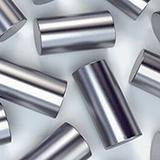Stainless steel pipes are subject to corrosion by harmful substances, and to prevent that they are often coated with a single or multiple layers of epoxy coatings. FBE coated pipes have a slim coating of epoxy-resin solution applied as a film on the entire length of the stainless steel pipes with the help of electrostatic spraying. Such FBE coated pipes can stand up to temperatures as high as 85oC.
Nowadays FBE Coating has become the standard form of protection for stainless steel pipes and stainless steel sheets against coercive substances and chemicals. Also, FBE coated pipes show numerous properties that are favorable to the industrial workload. Despite being flexible these pipes show high resistance when subjected to different soil pressures.
The acidic or alkaline nature of the soil at the industrial sites has been a major factor in the wear and tear of stainless steel pipes, however, Fusion bond epoxy pipes are founded to last longer under such conditions.
Here we have highlighted some of the main features of Fusion Bonded Epoxy (FBE) coated pipes:
- FBE coatings are highly resistive to chemical damages, therefore, they are applied as the outer coat of the steel pipes.
- The cathodic reaction is a phenomenon by which a layer loses its adhesive nature due to cathodic reactions or corrosion. FBE Coated pipes are resistive to such reactions.
- Steel pipes smoothness can wear away over time, the high strength of Fusion Bond Epoxy increases the life span of the steel pipes by adding protection to its smoothness.
Types of FBE coating
Single-layered FBE coating
This FBE coating is usually available in two coating grades that are Regular Grade with thickness up to 300μm and Strengthen Grade 400 μm. Out of the two types of grades strengthen grade coating Single-layered FBE coating is more popular in the oil and gas and water transportation industry.
Two-layered FBE coating
Well, if the conditions are harsher then an added layer of FBE is coating is applied to withstand the environment. This additional layer is also produced similarly as the first layer and is sprayed right above the first.
Generally, the inner layer mainly acts as a corrosion protector, while the second layer is applied for solid mechanical protection against the increases of the load.
Based on the nature of work, the dual-layer FBE also comes with an Abrasion-Resistant Overcoat (ARO). to negate the impact of mechanical loading and abrasions.
Often, the second layer is applied to the wet fists layer up to a minimum thickness of about 400 to 500 μm.
In addition to being used undergrounds, FBE pipes are also used in pipe bridges as they consist of a UV-resistant polyester layer.
For offshore projects, stainless steel pipes are often combined with cement mortar. In this case, there is a need for extra shear friction between the concrete and pipe. The second layer provides an increased amount of shearing resistance to prevent the cement mortar coat from sliding away and hold it tightly.
However, the life-span of an FBE coated pipe is usually 12 years therefore, a replacement is often needed. For this, one should opt for 3LPE pipes which have a lifespan of over 50 years.
